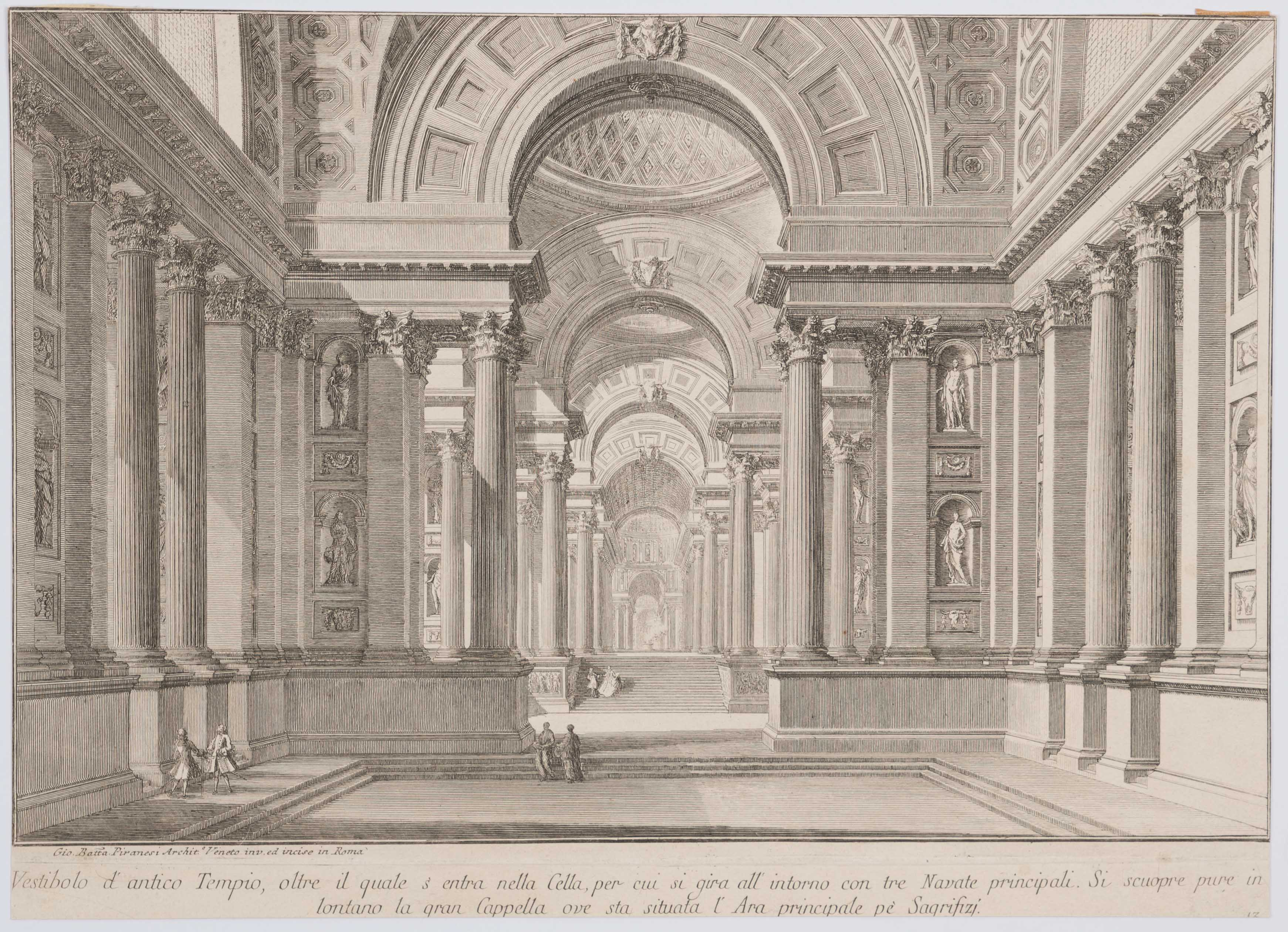Ancient Temple
< Back
Vestibule of an Ancient Temple [...] (Vestibolo d'antico Tempio [...]), Part One of the series “Architecture and Perspectives,” Plate 13, c. 1742, etching on wove paper, Sheet/Page (trimmed) 10 1/16 H x 14 W in. Gift from the Trustees of the Corcoran Gallery of Art (Bequest of Frank B. Bristow), GW Collection (CGA.68.26.700)
By Elizabeth Damon
Though classically trained in printmaking, Giovanni Battista Piranesi always considered himself an architect, depicting monumental architecture and invented spaces. His fascination with ancient Roman civilization found expression in varied depictions of ancient Roman society: recreated plans of archaic engineering, striking captures of crumbling ruins, and grand structures that were borne entirely of his imagination. The “pleasure of ruins” was spreading around Europe like wildfire, a wave that Piranesi rode with the art he was developing. One of his earliest series, Prima Parte di Architettura, e Prospettive, is primarily composed of imagined spaces on a grand scale. His time spent studying and reproducing the likenesses of ruins in Rome allowed him to greatly hone his skills in realistic depictions, and representing the former glory of ruins signaled his desire to capture more than just what was visible. His imagination is captured in an iconic quote: “I need to produce great ideas, and I believe that if I were commissioned to design a new universe, I would be mad enough to undertake it.” Piranesi’s etchings of potential great spaces reflect this deep inspiration.
The most immediately noticeable aspect of Vestibule of an Ancient Temple is the precise detail with which it is rendered. The entire image is only 10 inches tall and 13 ⅞ inches wide, yet Piranesi managed to pack every aspect of the composition with embellishments that bring the temple to life. This massive shrine is rendered in one-point perspective. This technique has a single vanishing point on the horizon where all lines converge, creating a receding view. The vanishing point falls at the top of the farthest arch in the distance, which draws attention to the main altar as the focal point of both the temple’s ritual use and the image itself.
Elaborate Corinthian columns tower over each of the three gaping cellae, supporting a thick frieze which runs the perimeter of each room, only interrupted by an arched entry to the next room. These arches have immense diameters that dramatically rise up over each doorway and emphasize the colossal scale of the temple. Support for the temple’s soaring ceiling is aided by three different shapes of coffers, carved out to lighten the load of the roof. Square coffers arc along each passageway, octagonal ones line the ceiling, and diamond-shaped coffers weave up towards a dome in the central room. Though a product of Piranesi’s imagination, this grandiose structure follows realistic constraints and is depicted in convincing depth.
Even when illustrating real spaces, Piranesi brought an illusionistic eye to each etching. His images of Rome became immensely popular because he embraced the hallmarks of Renaissance art, which included dramatic, dynamic compositions and starkly contrasted the elements of light and shadow. The influence of Raphael’s School of Athens can be clearly seen in this piece as well. The large, arching ceiling receding into the back echoes the vast space depicted in the famous fresco. Though empty, the halls of Piranesi’s etching beckon massive presences like those seen in Raphael’s painting, paying homage to the ideological implications of humanism.
Contrary to Raphael’s bustling paintings, Piranesi departed from this style with minimal depictions of human figures. Piranesi’s artistic attention to detail presented itself in the form of architectural embellishments, which arguably created equal movement and emotion as a human face. To accentuate the drama of his pieces, Piranesi toyed with the perspective from which a space was drawn, with Vestibolo d’antico Templo offering a view higher than a human would seen the space from. Another one of his works from “Views of Rome,” Veduta interna del Panteon (cat. #12), is from a high vantage point overlooking the massive cella. It is depicted with columns obscuring the view of the room unfolding in the distance, creating the illusion that it was drawn from an aerial view.
Piranesi’s prowess in blending realism with imagination set him apart as both an artist and architect. His works not only captured Rome’s past but reimagined its grandeur, reminding viewers of the civilization’s architectural excellence. Through masterful control of perspective, dramatic contrasts, and fastidious detail, he brought forth spaces that felt both historically grounded and imaginatively boundless. His influence extended beyond printmaking, shaping architectural ideas and assisting to renew appreciation for the antique world. Still today, Piranesi’s work is testament to his powerful artistic vision and commitment to redefine how history is perceived.
Inscription in Italian
Vestibolo & antico Tempio, oltre il quale 3 entra nella Cella, per cui si gira all intorno con tre Navate principali Si scuopre pure un lontano la gran Cappella ove sta situata l'Area principale per Sacrifizi.
English Translation by Andrew Gibson:
Vestibule of an ancient Temple, beyond which you enter the Cella, through which you round the three main Naves. One can also see in the distance the large Chapel in which the main sacrificial Altar is located.
Bibliography
Piranesi, Giovanni Battista, and Gillian Furlong. “The Ruins of Rome, Seen through 18th-Century Eyes.” In Treasures from UCL, 1st ed., 112–13. UCL Press, 2015. https://doi.org/10.2307/j.ctt1g69xrh.39.
Thompson, Wendy. “Giovanni Battista Piranesi (1720–1778).” In Heilbrunn Timeline of Art History. New York: The Metropolitan Museum of Art, 2000–. http://www.metmuseum.org/toah/hd/pira/hd_pira.htm (October 2003).
Zucker, Paul. “Ruins. An Aesthetic Hybrid.” The Journal of Aesthetics and Art Criticism 20, no. 2 (1961): 119–30. https://doi.org/10.2307/427461.


